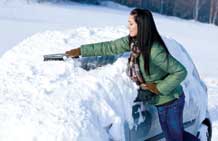When the weather outside is frightful, a little advance preparation will take the scare out of winter driving, says the Car Care Council. A few preventive vehicle maintenance steps will keep you from being stranded in severe winter weather.
“The thought of a breakdown, an engine not starting, or otherwise being stranded is scary as it is, but those things happening in freezing winter weather adds another level of fear,” said Rich White, executive director, Car Care Council. “An investment of an hour or so to have your vehicle checked will pay off and help make sure your winter driving is less frightful and more delightful.”
The Car Care Council recommends the following steps for winterizing your vehicle:br
- br
- Check the battery and charging system for optimum performance. Cold weather is hard on batteries.
- Clean, flush, and put new antifreeze in the cooling system. As a general rule of thumb, this should be done every two years.
- Make sure heaters, defrosters, and wipers work properly. Consider winter wiper blades and use cold weather washer fluid. Typically, wiper blades should be replaced every six months.
- If you’re due for a tune-up, have it done before winter sets in. Winter magnifies existing problems such as pings, hard starts, sluggish performance, or rough idling.
- Check the tire tread depth and tire pressure. If snow and ice are a problem in your area, consider special tires designed to grip slick roads. During winter, tire pressure should be checked weekly.
- Check the brakes. The braking system is the vehicle’s most important safety component.
- Inspect the exhaust system for carbon monoxide leaks, which can be especially dangerous during cold weather driving when windows are closed.
- Check to see that exterior and interior lights work and headlights are properly aimed.
- Be diligent about changing the oil at recommended intervals as dirty oil can spell trouble in winter. Consider changing to “winter weight” oil if you live in a cold climate. Check the fuel, air, and transmission filters at the same time.
brMotorists should also keep the gas tank at least half full at all times to decrease the chances of moisture forming in the gas lines and possibly freezing. Drivers should check the tire pressure of the spare in the trunk and stock an emergency kit with an ice scraper and snow brush, jumper cables, flashlight, flares, blanket, extra clothes, candles/matches, bottled water, dry food snacks, and needed medication.
For more driving tips, check the the Car Care Council website at www.carcare.org.


 View Print Edition
View Print Edition